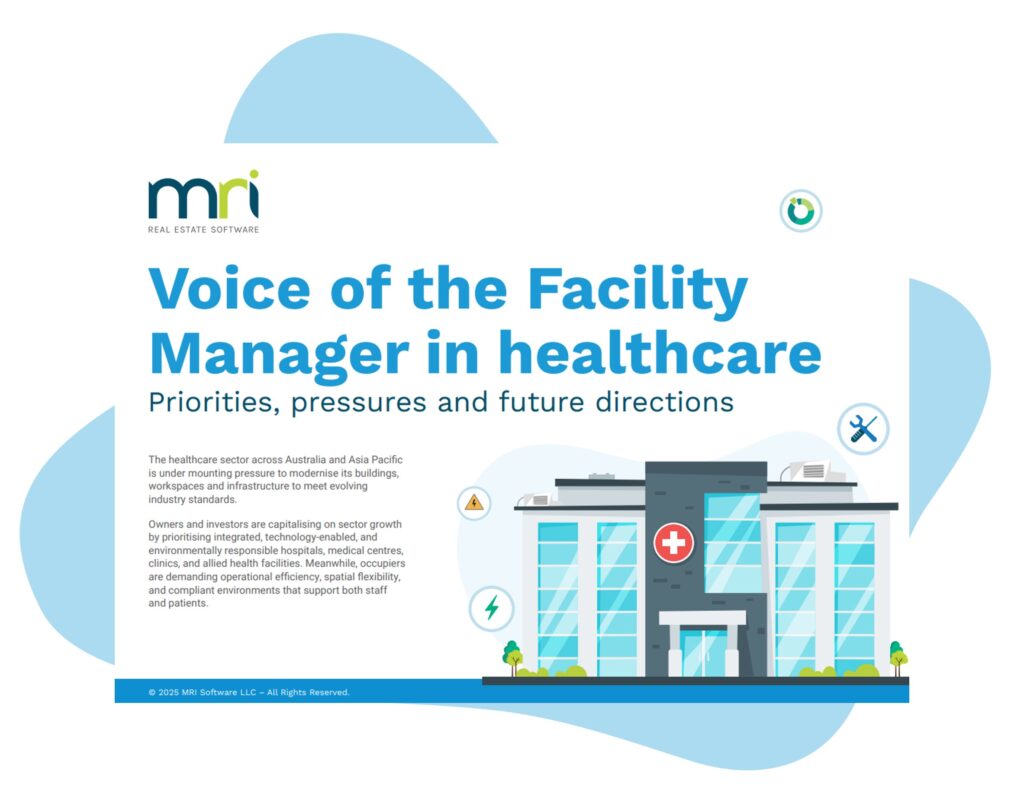What is failure analysis in real estate and facilities management?
Failure analysis is the study of why an asset or system fails, with the goal of preventing the same issue from occurring again. In real estate and facilities management, this practice is vital. Properties are made up of complex systems, from HVAC and electrical networks to roofs and automation technologies. When one component fails, it can disrupt operations, reduce tenant satisfaction, and damage long-term asset value.
Voice of the Facility Manager Report ANZ Edition
Discover the key trends and challenges shaping the FM industry in 2025.

Contents:
- Why failure analysis matters for asset managers
- Common types of failures in property portfolios
- The failure analysis process for real estate assets
- Tools that support failure analysis in property management
- Benefits of a proactive failure analysis strategy
- Best practices for real estate teams
- Real-world use cases and examples
- Building a smarter asset management strategy
- FAQs
MRI Software supports asset managers by providing tools that bring data, performance tracking, and maintenance insights into one place. A structured approach to facilities maintenance ensures that failures are not simply patched but properly investigated. Insights are connected to facilities metrics, giving property teams a clear picture of trends and risks. The process is further strengthened when aligned with robust maintenance management strategies that combine corrective action with prevention.
Techniques such as planned preventative maintenance and condition based maintenance are central to reducing the likelihood of failures. When breakdowns do occur, digital platforms like CMMS capture details, support root cause investigations, and track outcomes. By connecting these records with facilities management software, landlords and asset managers gain a framework for smarter decision-making and long-term resilience.
Why failure analysis matters for asset managers
Failure analysis matters because it transforms how landlords protect investments, maintain tenant trust, and manage compliance obligations. Without it, failures are often treated as isolated incidents. The same problems resurface, costs escalate, and assets decline prematurely. With it, failures become opportunities for learning and improvement.
Protecting investment value
Every building system represents an investment. When failures occur repeatedly, the value of that investment erodes. A leaking roof that is patched several times without investigating underlying design flaws will continue to deteriorate. Moisture damage may extend to structural components, leading to far greater costs than the original repair. Failure analysis addresses the source rather than the symptom. For landlords, this means capital is preserved, asset lifespans are extended, and resale values are maintained.
Consider a retail centre where lighting systems fail frequently. A surface-level fix might involve replacing bulbs or ballasts. Failure analysis, however, may reveal electrical design faults causing premature wear. By addressing the design, the landlord prevents future costs and protects long-term asset performance.
Minimising operational disruption
Operational continuity is a priority in commercial real estate. A malfunctioning HVAC system in an office tower can render space unfit for tenants. Plumbing failures in a residential complex can force units out of service. Each disruption creates reputational risk and financial loss.
Failure analysis helps minimise these disruptions by uncovering the true drivers of outages. If repeated lift breakdowns are traced to misaligned maintenance schedules, corrective measures can be implemented. Tenants benefit from fewer disruptions, and landlords maintain stronger lease relationships.
Supporting compliance and risk mitigation
Compliance with safety, accessibility, and environmental standards is not optional. Failures in these areas can create serious legal and financial consequences. Fire safety systems that repeatedly malfunction, for example, expose owners to liability and put occupants at risk.
By incorporating compliance incidents into failure analysis, property teams ensure that root causes are documented and addressed. This demonstrates accountability to regulators and insurers. It also strengthens internal risk management frameworks, creating confidence for both tenants and investors.
Common types of failures in property portfolios
Understanding common failure types helps landlords anticipate risks and apply appropriate strategies.
HVAC, electrical, and plumbing system failures
Mechanical and utility systems are critical to daily operations. HVAC units fail due to blocked filters, neglected servicing, or defective parts. Electrical networks may overload, creating outages or safety hazards. Plumbing failures, such as bursts or drainage issues, can lead to significant tenant disruption and property damage.
Analysing these failures often uncovers patterns. A series of HVAC failures may indicate inadequate filter maintenance. Electrical issues may point to design shortcomings in older buildings. Identifying patterns across a portfolio allows asset managers to prevent repeat failures and improve reliability.
Structural asset failures
Structural elements such as façades, roofs, and foundations can fail with costly consequences. Roof leaks left untreated may compromise insulation and ceiling systems. Façade failures can pose safety risks to pedestrians and tenants. Failure analysis in these cases examines installation quality, material performance, and inspection history.
By identifying whether the root cause lies in poor design, inadequate maintenance, or natural wear, landlords can plan appropriate remediation. This proactive stance protects safety and prevents costly litigation.
Lifecycle failures due to deferred maintenance
When maintenance is deferred, assets reach failure points earlier than expected. Budget restrictions often lead to short-term savings at the expense of long-term costs. Failure analysis highlights the financial risks of deferral. For instance, lift systems neglected during routine cycles may require full replacement years ahead of schedule.
Analysing deferred maintenance failures provides evidence for investing in preventative approaches. It demonstrates the long-term financial advantages of timely action and supports stronger budgeting practices.
Technology failures in building automation systems
Modern buildings rely on automation for climate control, lighting, and security. Failures in these systems can stem from software bugs, outdated hardware, or integration issues. While the immediate solution may be to reset or replace components, failure analysis identifies systemic issues such as compatibility gaps between platforms.
Understanding these technology failures is essential for portfolios that rely heavily on automation to meet energy and sustainability goals. It also ensures that cyber security risks are considered as part of failure management.
The failure analysis process for real estate assets
A structured process ensures that failures are investigated thoroughly and corrective actions are applied effectively.
Step 1: Identify the failure event
The first step is accurate identification. Work orders, tenant reports, and maintenance logs are valuable tools. Recording the date, location, and nature of the failure provides a factual basis for investigation. Clear data capture prevents misinterpretation and ensures that every incident is documented for future reference.
Step 2: Conduct root cause analysis
Root cause analysis investigates beyond the immediate issue. This may involve technical inspections, testing, or consulting external experts. A recurring electrical outage might initially appear to be a wiring fault. Investigation could reveal that overloaded circuits are the true cause, linked to increased tenant energy demands.
This deeper analysis prevents misdirected spending. Rather than repeatedly repairing wiring, the landlord can upgrade capacity and prevent recurrence.
Step 3: Document findings and actions
Documentation is critical. Findings must be recorded in a structured format, detailing causes, corrective actions, and outcomes. This creates a knowledge base that can be referred to across the portfolio. Documentation also supports compliance audits and provides transparency for investors.
Step 4: Implement preventive strategies
The final step is to apply preventive measures. These may include updating maintenance schedules, replacing faulty materials, or investing in new monitoring technologies. Preventive strategies should be reviewed over time to ensure they remain effective. The goal is not only to fix the issue but also to build resilience against future failures.
Tools that support failure analysis in property management
Technology makes failure analysis more efficient and effective by consolidating data and providing predictive insights.
CMMS and facilities management software
A CMMS is the foundation for modern failure analysis. It centralises incident reporting, work orders, and maintenance records. When integrated with facilities management software, it provides visibility across entire portfolios. Trends can be identified, recurring failures tracked, and accountability maintained.
Asset performance dashboards
Dashboards present data in real time. Metrics such as uptime, downtime, energy consumption, and repair frequency highlight underperforming assets. By visualising these insights, landlords can prioritise interventions and allocate resources strategically.
Predictive maintenance modules
Predictive maintenance modules use sensor data and analytics to forecast failures before they occur. For instance, vibration sensors on HVAC units can detect early wear in motors. By addressing issues before breakdowns, downtime is reduced, and assets last longer.
Integration with lease and capital planning tools
Failure data becomes even more powerful when integrated with leasing and capital planning systems. If a property consistently experiences plumbing failures, this data can be considered in lease negotiations, budget forecasts, or capital improvement plans. This integration ensures that failure insights support broader business decisions.
Benefits of a proactive failure analysis strategy
Proactive failure analysis delivers substantial benefits that extend beyond fixing assets.
Financially, it reduces the cost of repeated repairs and prevents capital assets from deteriorating prematurely. It also supports more accurate budgeting by linking historical failure data to future forecasts.
Operationally, it creates smoother tenant experiences by reducing disruption. Tenants in properties with fewer outages are more likely to renew leases and recommend the property to others.
Reputationally, it demonstrates professionalism and accountability. Investors, regulators, and tenants all gain confidence when landlords can show evidence of structured failure management.
Strategically, it creates resilience. Markets and technologies change, but a proactive failure analysis strategy ensures that portfolios can adapt and remain competitive.
Best practices for real estate teams
To get the most from failure analysis, teams should:
- Establish consistent data collection standards across all sites, ensuring every failure is captured accurately
- Train staff to conduct structured root cause investigations rather than applying surface-level fixes
- Use software platforms to centralise insights and share knowledge across portfolios
- Review and update strategies annually to incorporate lessons learned
By embedding these practices, real estate teams create a cycle of continuous improvement that strengthens both operations and investment outcomes.
Real-world use cases and examples
Failure analysis delivers practical results in real scenarios.
- Commercial office tower: Frequent lift breakdowns frustrate tenants. Analysis shows that deferred maintenance accelerated wear. By adjusting service schedules and replacing worn parts early, breakdowns decline, tenant satisfaction improves, and lease renewals increase.
- University campus: Boilers fail during peak winter demand. Investigation reveals that the units are undersized for current usage. By replacing them with properly sized systems, the campus prevents future outages and protects student wellbeing.
- Retail shopping centre: Electrical failures disrupt weekend trading. Analysis highlights overloaded circuits caused by tenant expansions. Reinforcing the infrastructure prevents future outages and protects rental income.
- Government facilities: Repeated roof leaks occur in multiple buildings. Investigation reveals poor original installation practices. By scheduling comprehensive replacements, the government agency protects public safety and reduces liability risks.
Building a smarter asset management strategy
Failure analysis is a cornerstone of effective asset management. It transforms failures from isolated incidents into opportunities for long-term improvement. By identifying root causes, documenting actions, and implementing preventive measures, landlords can protect property value, reduce disruption, and strengthen compliance. With the support of modern technology, failure analysis becomes a proactive strategy that underpins smarter, more resilient property management.
FAQs
What is failure analysis in property and facilities management?
Why is failure analysis important for asset managers?
What are common failure types in commercial property portfolios?
How can software support failure analysis in real estate management?
How does failure analysis support long-term maintenance planning?
Contact MRI Software
To learn how technology can support your failure analysis strategy, contact MRI Software on 1300 657 700.
Voice of the Facility Manager in healthcare
How are healthcare facilities evolving to meet the demands of a modern system? Across Australia and the Asia Pacific, the healthcare sector is under growing pressure to modernise buildings, workspaces, and infrastructure in line with evolving industr…
